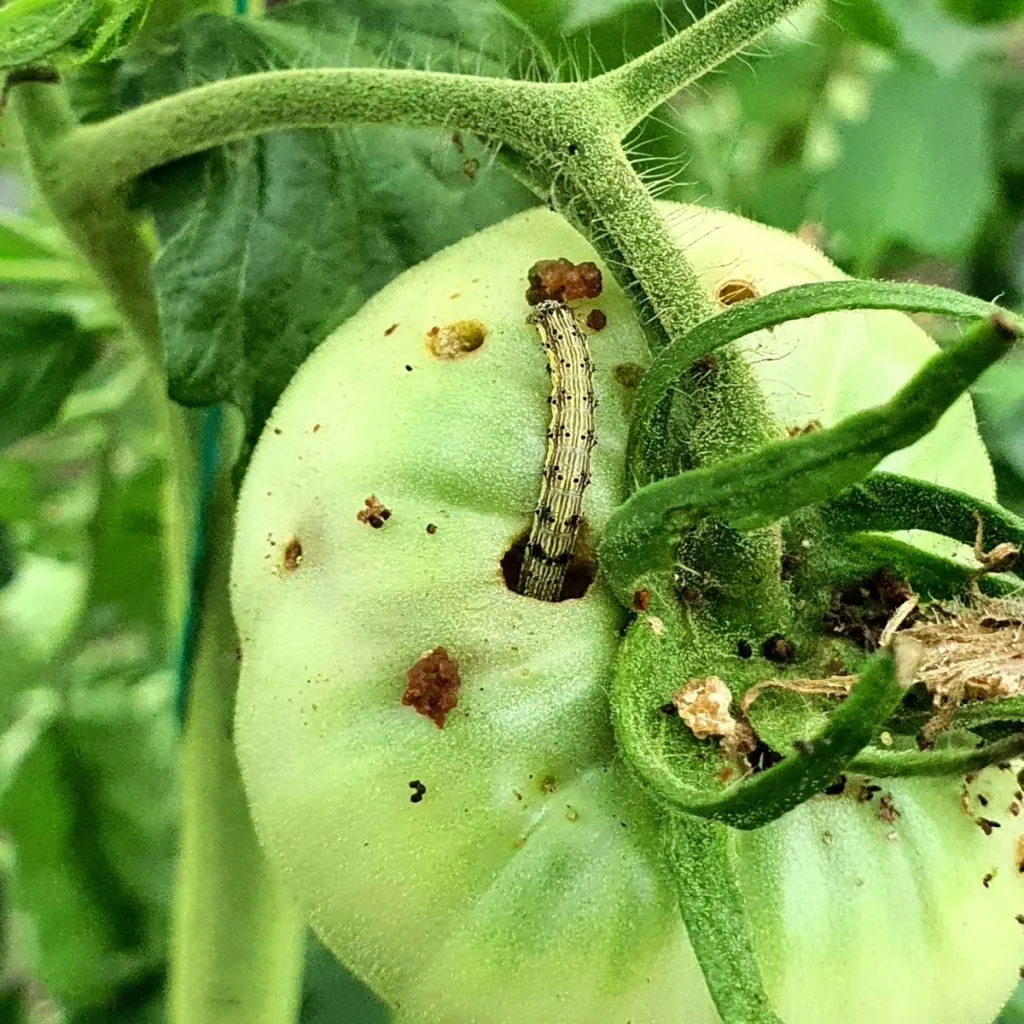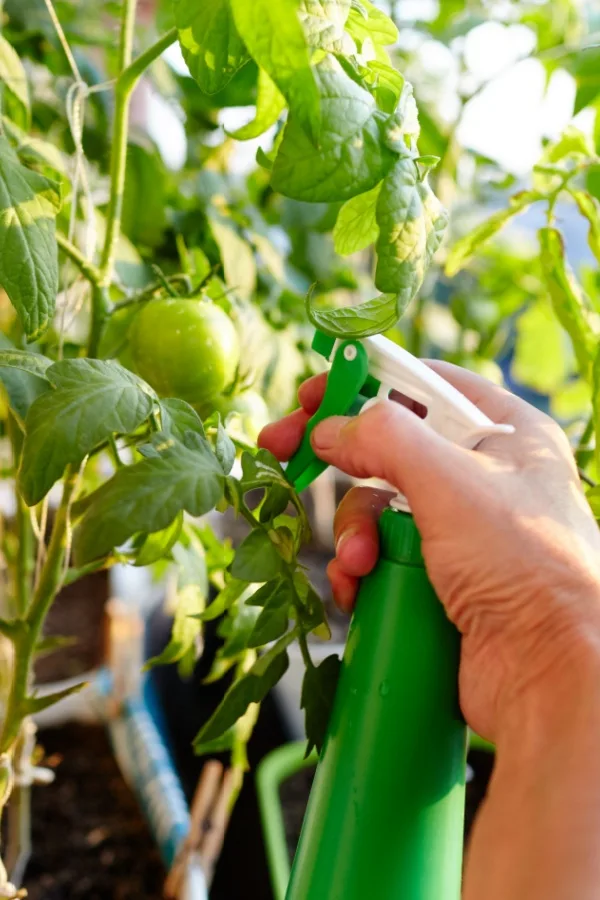Now that your tomato plants are growing in full swing, it’s time to start keeping an eye out for some of the major pests that can quickly ruin your harvest – and one of the worst offenders that you need to be sure to stop are tomato fruitworms!
Tomato fruitworms also go by the names of corn earworm and cotton bollworm. All of these pests are actually the same species – they’ve just been given different names depending on the plant they happen to be attacking.
What makes fruitworms especially bad is that they can switch from plant species to plant species while in the adult stage. Which means about the time your sweetcorn patch starts to get dry silks, the adult earworm moths start to look for a new host to lay their eggs – and your newly formed green tomatoes make the perfect spot!

Once the eggs hatch, the tomato fruitworms bury down deep into the tomatoes, taking just a few bites to ruin the unripe fruit before moving on to the next. Before you know it, your entire harvest of tomatoes has been damaged by these tiny pests.
While identifying an infestation early is key to the health and success of your tomato plants, there are still a few simple ways to stop these insects without having to resort to harsh chemicals or sprays.
What Are Tomato Fruitworms?
Tomato fruitworms, corn earworms, and cotton bollworms are an agriculture pest that can actually decimate a long list of garden crops.
In addition to tomatoes, corn and cotton, they will also go after asparagus, cabbages, melons, cucumbers, pumpkins, eggplants, squash, sweet potatoes, legumes and other vegetables and fruits. That means a diverse garden can end up with multiple variants of the pests on several different crops – all at the same time!
An interesting fact about tomato fruitworms is that they do not overwinter in Midwestern or Northern locations due to the colder winters. Instead, after hatching in the spring, the moths migrate miles each night before reaching those locations.
Tomato Fruitworm Lifecycle – Stop Tomato Fruitworms
Tomato fruitworms start off as moths that emerge from pupae in April or May. They are usually light tan or brown but some have a slight green hue. Some of the moths migrate to Northern locations to find places to lay eggs.

Around dusk, the moths lay eggs on the foliage of host plants like tomatoes. The tiny eggs only measure around half a millimeter but are usually found in clusters. After about 2 to 10 days, the larva hatch.
The larvae can grow up to 1.5 to 2 inches long and are brown, green, yellow, black, or even pink. They stay as larvae for only 14 to 21 days, but that is plenty of time to cause massive damage to your tomatoes.
Once their time is up, the larvae drop to the ground and either enter the soil where they turn into pupae or they die off in Northern climates. The life cycle can repeat itself two to three times each year.
Identifying Fruitworms And Their Damage
When it comes to tomato fruitworms, the larvae tunnel into the unripe fruit. You might notice a dark hole at the base of the fruit stem where the caterpillars first enter the fruit. A single caterpillar will feed on several unripe tomatoes within its lifetime. This can result in multiple fruit on one plant being ruined.

If there are no tomatoes available, the larvae will move on to feed on the flowers, leaves, and stems of the plant. These holes can leave plants susceptible to bacterial or fungal infections in addition to reducing their yields
How To Stop Tomato Fruitworm Damage
Early Prevention
One of the best ways to stop tomato fruitworms from ruining your tomato harvest is early intervention and prevention. The sooner you find and stop the damage, the better the chances are to save your plants.
When laying out your garden space, avoid planting tomatoes near sweetcorn, popcorn, or field corn plots. This helps to reduce the chances of tomato fruitworms moving from the corn to your tomato plants. See our article: 5 Plants To Never Grow Near Tomato Plants
Once your plants are up and growing, make a point of walking your tomato plants every day if possible. Spending 5 to 10 minutes each day in your garden is the best way to spot early signs of insect or pest damage and to catch signs of fungal or bacterial diseases as well.

Look for the presence of eggs on both sides of the plant’s leaves. The moths usually lay the eggs toward the top half of the plant. Since the eggs are so small, they might be a bit difficult to see. Remove any that you find by smashing them or dropping them into a bucket of soapy water.
Signs of fruit or foliage damage usually appear in late June or early July. Remove and discard any damaged fruit and hand remove larvae if found. While it might take some time, persistence will pay off in the long run.
Neem Oil – How To Stop Tomato Fruitworms
A great, all-natural way to stop tomato fruitworms from ruining your harvest is to use neem oil. Neem oil is extracted by pressing on the seeds of neem trees. This oil is a 100% organic product that has been used for hundreds of years to treat all kinds of garden issues.
Not only will it help keep several different types of garden pests away, but it also helps to control fungal and bacterial diseases. What’s even better is that it’s effective at stopping tomato fruitworms at all stages of their lifecycle. At the same time, it is completely safe for pollinators when used correctly.

You can purchase ready-to-use neem oil that can be immediately sprayed on tomato plants. Or, you can create a simple solution using concentrated neem oil. Always be sure to read product labels before using to best apply. Product Link: Natria Neem Oil Spray
Simply mix one ounce of neem oil for each gallon of water. Add in a few drops of liquid dish soap and mix well. Spray this solution on your tomato plants either early in the morning or late at night. This is when most pollinators are least active. Be sure to saturate both sides of the foliage.
Bt Applications
Bt (Bacillus thuringiensis) is a soil-borne bacteria that occurs naturally and is approved for use in organic gardening. The good news is that Bt is safe for humans, but it is great for stopping many unwanted pests, including tomato fruitworms. Product Link: Monterey B.T. Concentrate
Proper timing of using Bt is key in stopping tomato fruitworms. In order for it to be successful, the caterpillars must consume the product.
This means you need to apply the Bt before they burrow down into the fruit and before they drop down onto the soil to make their cocoons. The best time to do this is right after the eggs hatch.
Use the product as directed on the label. Spray the product on both sides of the leaves of your tomato plants early in the morning. For larger infestations, you will most likely need to reapply after a week with a second application.
By staying on top of your tomato crops and keeping an eye out for early damage, you can easily stop tomato fruitworms from overtaking and ruining your harvest this year!
I Grow Tomatoes
Follow Our Facebook Page For Even More Great Tomato Growing Tips! I Grow Tomatoes Facebook Page
I Grow Tomatoes is a website created for those who love all things about tomatoes – from planting and growing – to cooking and canning! We publish two articles every week, 52 weeks a year. Sign up today to follow via email! This article may contain affiliate links.

